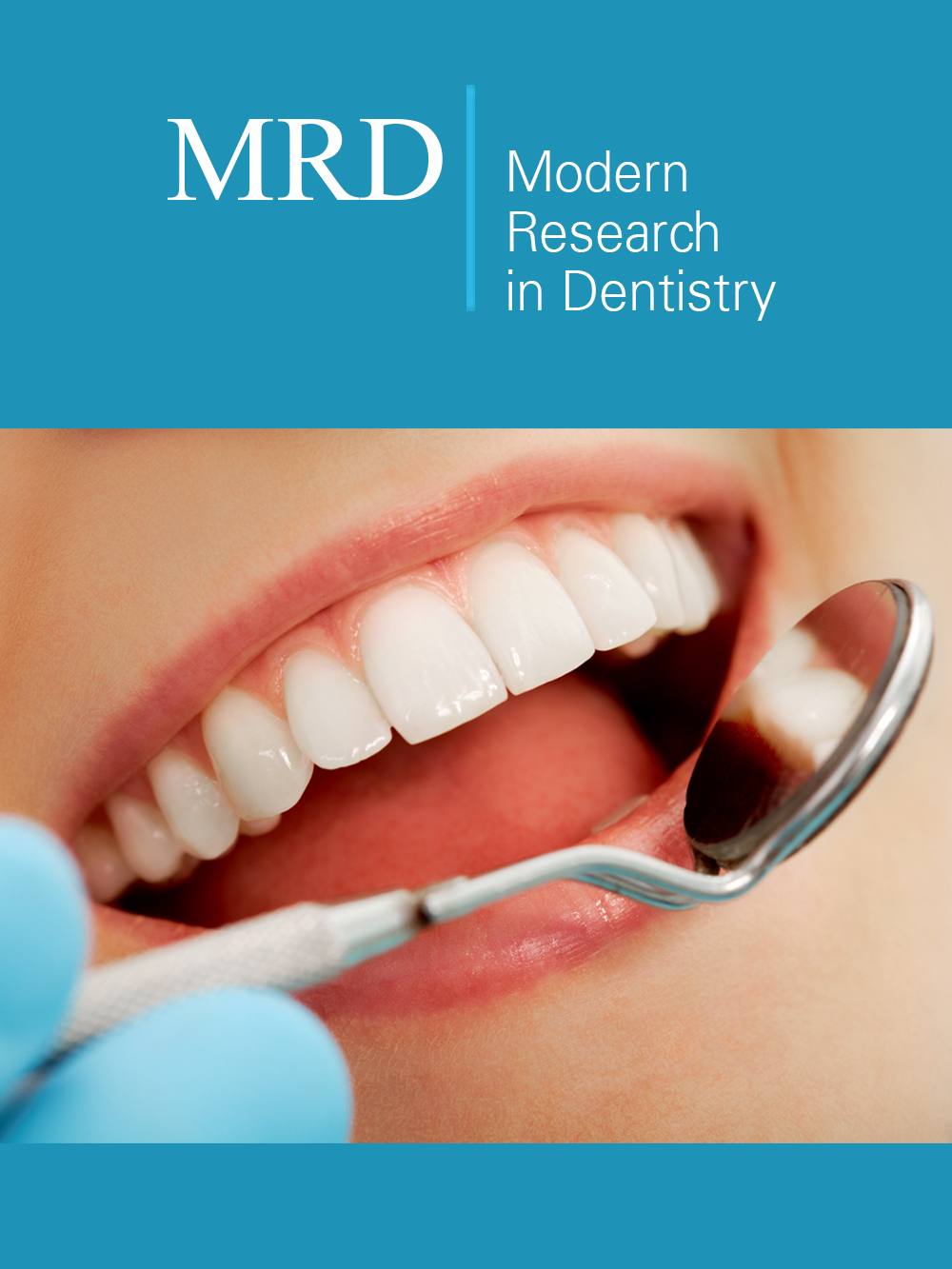- Submissions

Full Text
Modern Research in Dentistry
The Impact of Artificial Intelligence on Oral Surgery Practices
Omid Panahi* and Mohammad Zeinaldin
Department of Helathcare Management, University of the People, USA
*Corresponding author: Omid Panahi, University of The People, Department of Helathcare Management, California, USA
Submission: November 04, 2024;Published: December 12, 2024

ISSN:2637-7764Volume8 Issue2
Abstract
Artificial Intelligence (AI) is rapidly transforming the landscape of healthcare, and oral surgery is no exception. This paper explores the potential benefits and challenges of integrating AI into oral surgery practices. By examining the current state of AI in oral surgery, its potential applications, such as AI-powered image analysis for early detection of oral cancer and AI-assisted robotic surgery for precise implant placement, and the ethical considerations associated with its use, we aim to provide a comprehensive overview of the impact of AI on this field. Additionally, we will discuss the potential impact of AI [1,2] on dental education and training.
Introduction
Artificial Intelligence (AI) has rapidly emerged as a transformative force across various industries, and healthcare is no exception. Oral surgery, a specialized field of dentistry, is poised to benefit significantly from the integration of AI technologies. This paper delves into the potential applications of AI in oral surgery, exploring its impact on diagnosis, treatment planning, surgical procedures, and patient care. By examining the current state of AI in oral surgery, its potential benefits, and the challenges associated with its implementation, we aim to provide a comprehensive overview of this exciting and rapidly evolving field.
AI offers a wide range of potential applications in oral surgery, including:
1. Enhanced diagnosis: AI-powered image analysis tools can analyze digital images
of oral tissues, such as those obtained from intraoral cameras or biopsies, to identify
early signs of oral cancer and other diseases with greater accuracy and sensitivity than
traditional methods.
2. Improved surgical planning: AI [3-5] algorithms can analyze patient data,
including CT scans and 3D models, to create detailed surgical plans, optimizing treatment
outcomes and minimizing risks.
3. Minimally invasive procedures: AI-assisted robotic surgery can enable more
precise and less invasive procedures, reducing patient discomfort and recovery time.
4. Personalized treatment: AI can analyze patient data to develop personalized
treatment plans, tailoring interventions to individual needs and increasing the likelihood
of successful outcomes.
5. Efficient workflow: AI-powered automation can streamline administrative tasks
and reduce the burden on healthcare professionals, allowing them to focus on patient
care.
AI in Dental Schools: The Future of Dental Education
The integration of AI into dental schools is rapidly transforming dental education and
training. Here are some keyways AI [6-9] are being implemented:
Enhanced Learning Experiences
AI-powered simulations
i. Virtual Reality (VR) and Augmented Reality (AR): These
technologies can create immersive learning environments
where students can practice complex procedures in a risk-free
setting.
ii. Patient simulation: AI-driven patient simulators can
replicate real-life clinical scenarios, allowing students to
develop clinical skills and decision-making abilities.
Personalized learning
i. Adaptive learning platforms: AI [10,11] algorithms
can tailor educational content to individual student needs,
optimizing learning outcomes.
ii. Intelligent tutoring systems: AI-powered tutors can
provide personalized feedback and support, helping students
to master difficult concepts.
Advanced Research and Innovation
AI-Driven Research
i. Data analysis and insights: AI can analyze large datasets
to identify trends, patterns, and correlations, leading to new
discoveries and innovations in dental research.
ii. Predictive modeling: AI models can predict disease
progression and treatment outcomes, enabling early
intervention and personalized treatment plans.
Biomedical engineering and AI
i. AI-designed dental implants: AI can optimize the design
of dental implants, improving their biocompatibility and
longevity.
ii. AI-assisted surgical robotics: AI-powered robotic systems
can enhance the precision and accuracy of surgical procedures.
Improved Patient Care
AI-assisted diagnosis
i. Image analysis: AI algorithms can analyze dental X-rays
and other imaging data to detect early signs of oral diseases,
such as oral cancer and periodontal disease.
ii. Predictive analytics: AI [12,13] can predict future
dental health risks, allowing for preventive interventions and
personalized treatment plans.
Remote dental care
Teledentistry: AI-powered telemedicine platforms can enable remote consultations and monitoring of patients, improving access to dental care, especially in underserved areas.
As AI continues to evolve, its impact on dental education and practice will only grow. By embracing AI technologies, dental schools can prepare future dentists to meet the challenges of the 21st century and provide the highest quality of care to their patients.
AI in Dental Offices: Revolutionizing Oral Healthcare
The integration of AI into dental offices is transforming the way
oral healthcare is delivered. Here are some of the key applications
of AI [14,15] in dental practice:
Enhanced Diagnosis
AI-powered image analysis
i. Early detection of oral cancer: AI algorithms can analyze
digital images of oral tissues, such as those obtained from
intraoral cameras or biopsies, to identify early signs of oral
cancer with greater accuracy and sensitivity than traditional
methods.
ii. Periodontal disease detection: AI-powered software
can analyze dental X-rays to detect early signs of periodontal
disease, enabling timely intervention and preventing further
damage.
Improved Treatment Planning
AI-assisted treatment planning
i. Personalized treatment plans: AI algorithms can analyze
patient data, including medical history, dental records, and 3D
scans, to develop personalized treatment plans.
ii. Predictive analytics: AI can predict the potential outcomes
of different treatment options, helping dentists make informed
decisions.
Advanced Dental Procedures
AI-assisted robotic dentistry
Precise implant placement: AI-powered robotic systems can assist dentists in performing precise implant placement procedures, reducing surgical time and improving patient outcomes.
Digital dentistry
CAD/CAM Dentistry: AI-driven CAD/CAM systems can design
and fabricate custom dental restorations, such as crowns and
bridges, with greater precision and efficiency.
Enhanced Patient Experience
AI-powered patient communication
i. Automated appointment scheduling: AI-powered
scheduling systems can optimize appointment times and
reduce wait times.
ii. Personalized patient education: AI-driven chatbots
can provide personalized information and answer patient
questions, improving patient satisfaction.
Remote dental care
Teledentistry: AI-powered telemedicine platforms enable remote consultations, allowing patients to access dental care from the comfort of their homes.
By embracing AI technologies, dental offices can improve patient care, enhance efficiency, and stay ahead of the curve in the ever-evolving field of dentistry.
Methodology
This paper employs a literature review approach to explore the current state of AI in oral surgery. Relevant articles, research papers, and clinical studies were identified through a systematic search of databases such as PubMed, Scopus, and Google Scholar. The keywords used for the search included “artificial intelligence,” “machine learning,” “deep learning,” “oral surgery,” “dental surgery,” and “medical imaging.”
The identified articles were critically analyzed to extract key
information, including:
1. AI applications in oral surgery: This includes the specific
AI techniques employed, such as machine learning, deep
learning, and computer vision.
2. Benefits and limitations of AI: The advantages and
disadvantages of AI in oral surgery were assessed, including
improved diagnostic accuracy, enhanced surgical planning, and
reduced patient discomfort.
3. Ethical considerations: The ethical implications of AI in
oral surgery, such as data privacy, algorithmic bias, and the
potential for job displacement, were explored.
4. Future directions: The potential future developments and
challenges in AI-driven oral surgery were discussed.
5. By systematically reviewing the existing literature, this
paper aims to provide a comprehensive overview of the current
state of AI in oral surgery and its potential impact on the field.
Benefits of AI in Oral Surgery
The integration of AI into oral surgery offers a multitude of benefits, including:
Enhanced diagnosis
Early detection of oral cancer: AI-powered image analysis tools can analyze digital images of oral tissues, such as those obtained from intraoral cameras or biopsies, to identify early signs of oral cancer with greater accuracy and sensitivity than traditional methods. This can lead to earlier diagnosis and treatment, improving patient outcomes.
Improved surgical planning
Precise implant placement: AI [16] algorithms can analyze patient data, including CT scans and 3D models, to create detailed surgical plans for implant placement. This can help surgeons plan the optimal position and orientation of implants, reducing the risk of complications and improving the long-term success of implant treatment.
Minimally invasive procedures
AI-assisted robotic surgery: AI-powered robotic systems can assist surgeons in performing minimally invasive procedures with greater precision and accuracy. This can lead to reduced surgical trauma, faster healing times, and improved patient comfort.
Personalized treatment
Tailored treatment plans: AI can analyze patient data to develop personalized treatment plans, taking into account factors such as age, medical history, and specific clinical needs. This can lead to more effective and efficient treatment.
Efficient workflow
Automated tasks: AI-powered automation can streamline administrative tasks and reduce the burden on healthcare professionals, allowing them to focus on patient care.
By leveraging the power of AI, oral surgeons can provide more accurate diagnoses, plan more effective treatments, and perform more precise surgeries, ultimately improving patient outcomes and enhancing the overall quality of oral healthcare.
Challenges of AI in Oral Surgery
While the potential benefits of AI in oral surgery are significant, there are several challenges that need to be addressed to ensure its successful integration into clinical practice:
Data quality and quantity
AI algorithms require large amounts of high-quality data to train effectively. Acquiring and curating such data can be a significant challenge in the field of oral surgery, as it often involves sensitive patient information and requires specialized expertise.
Ethical considerations
The use of AI in healthcare raises ethical concerns, such as data privacy, algorithmic bias, and the potential for job displacement. It is essential to establish clear ethical guidelines and regulations to ensure that AI is used responsibly and ethically.
Regulatory hurdles
The integration of AI into clinical practice requires careful consideration of regulatory frameworks and standards. Regulatory bodies need to adapt to the rapid advancements in AI technology and develop appropriate guidelines to ensure patient safety and efficacy.
Technical expertise
Implementing AI technologies in oral surgery practices requires specialized technical knowledge and expertise. Healthcare professionals may need additional training to understand and effectively utilize AI tools.
Cost
The development and implementation of AI technologies can be costly, particularly for smaller practices. The cost-effectiveness of AI solutions needs to be carefully evaluated to ensure a positive return on investment.
Conclusion
Artificial intelligence is poised to revolutionize the field of oral surgery. From enhancing diagnostic accuracy to enabling minimally invasive procedures, AI offers numerous benefits that can improve patient care and outcomes. By leveraging AI-powered tools, oral surgeons can streamline workflows, make more informed decisions, and provide more personalized treatment plans. However, the successful integration of AI [17] into oral surgery requires careful consideration of ethical implications, regulatory frameworks, and data privacy concerns. It is essential to establish clear guidelines and standards to ensure the responsible and ethical use of AI in healthcare.
As AI technology continues to advance, its impact on oral surgery will only grow. By embracing innovation and adapting to technological advancements, oral surgeons can position themselves at the forefront of dental care, delivering superior patient outcomes and driving the future of dentistry.
References
- Panahi O, Zeinaldin M (2024) Digital dentistry: Revolutionizing dental care. J Dent App 10 (1): 1121.
- Panahi O (2024) AI in surgical robotics: Case studies. Austin J Clin Case Rep 11(7): 1342.
- Panahi O, Zeinaldin M (2024) AI-assisted detection of oral cancer: A comparative analysis. Austin J Pathol Lab Med 10(1): 1037.
- Omid P, Reza S (2024) How artificial intelligence and biotechnology are transforming dentistry. Adv Biotech & Micro 18(2): 555981.
- Omid P (2024) Modern sinus lift techniques: Aided by AI. Glob J Oto 26(4): 556198.
- Panahi O (2024) Bridging the gap: AI-driven solutions for dental tissue regeneration. Austin J Dent 11(2): 1185.
- Omid P (2024) Artificial intelligence in oral implantology, its applications, impact and challenges. Adv Dent & Oral Health 17(4): 555966.
- Omid P (2024) Empowering dental public health: Leveraging artificial intelligence for improved oral healthcare access and outcomes. JOJ Pub Health 9(1): 555754.
- Omid Panahi (2024) AI: A new frontier in oral and maxillofacial surgery. Acta Scientific Dental Sciences 8(6): 40-42.
- Omid Panahi (2024) Teledentistry: Expanding Access to Oral Healthcare. Journal of Dental Science Research Reviews & Reports, SRC/JDSR-203.
- Omid Panahi (2024) Artificial intelligence: A new frontier in periodontology. Mod Res Dent 8(1): MRD. 000680.
- Omid Panahi (2024) AI ushering in a new era of digital dental-medicine. Acta Scientific Medical Sciences 8(8): 131-134.
- Omid Panahi, Mohammad Zeinalddin (2024) The remote monitoring toothbrush for early cavity detection using artificial intelligence (AI). IJDSIR 7(4): 173-178.
- Omid Panahi, Reza Safaralizadeh (2024) AI and dental tissue engineering: A potential powerhouse for regeneration. Mod Res Dent 8(2): MRD.000682.
- Omid Panahi (2024) Dental implants & the rise of AI. On J Dent & Oral Health 8(1): OJDOH.MS.ID.000679.
- Panahi O (2024) The rising tide: Artificial intelligence reshaping healthcare management. SJ Publc Hlth 1(1): 1-3.
- Panahi O, Zeinalddin M (2024) The convergence of precision medicine and dentistry: An AI and robotics perspective. Austin J Dent 11(2): 1186.
© 2024 Omid Panahi. This is an open access article distributed under the terms of the Creative Commons Attribution License , which permits unrestricted use, distribution, and build upon your work non-commercially.
 a Creative Commons Attribution 4.0 International License. Based on a work at www.crimsonpublishers.com.
Best viewed in
a Creative Commons Attribution 4.0 International License. Based on a work at www.crimsonpublishers.com.
Best viewed in 







.jpg)






























 Editorial Board Registrations
Editorial Board Registrations Submit your Article
Submit your Article Refer a Friend
Refer a Friend Advertise With Us
Advertise With Us
.jpg)






.jpg)














.bmp)
.jpg)
.png)
.jpg)










.jpg)






.png)

.png)



.png)






